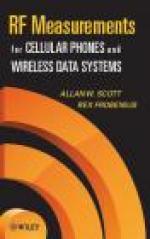Third order intercept point. The point where the output power of the fundamental tones would equal that of the third order intermodulation products if the linear performance of the device would continue for all input power levels. In actual practice, the linear performance degrades starting at the 1dB compression point, so the third order intercept point can never be achieved. Nonetheless it demonstrates the ability of an amplifier, particularly in receivers, to handle strong signal power levels without distortion. The higher the value the better the performance.
See also: Wikipedia article.
www.rfmentor.com
Tools and training to help your RF/Wireless career
Menu
Main menu
Quick Links
User menu
User login
Popular content
- Parasitic Oscillations and EMI Emissions
- Test EMI Profile of Your Systems with Real Loads
- Applied RF Engineering I online (Course 270)
- Microwave Journal Magazine
- Live and On-Demand RF/Wireless Courses from Besser Associates
- PCB Design Toolkit
- Digital Communications: Fundamentals and Applications (2nd Edition)
- Broadband Impedance Matching
- QUCS Freeware Circuit Simulator
- Videos from Microwave Journal


